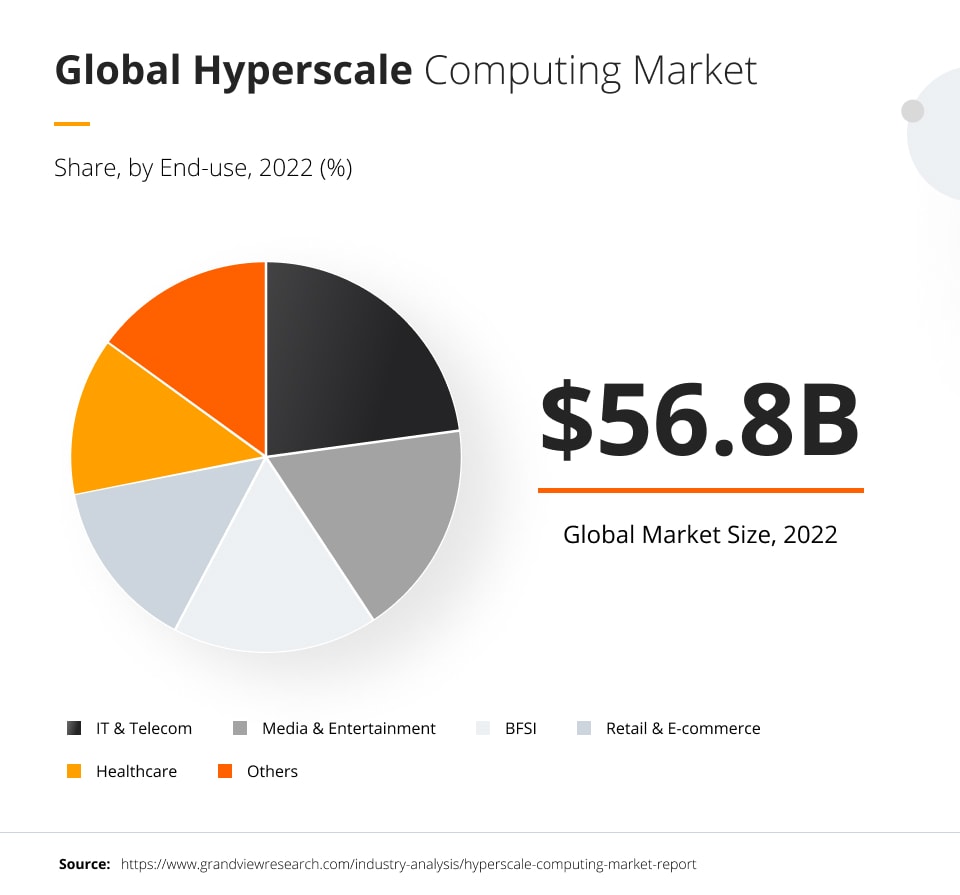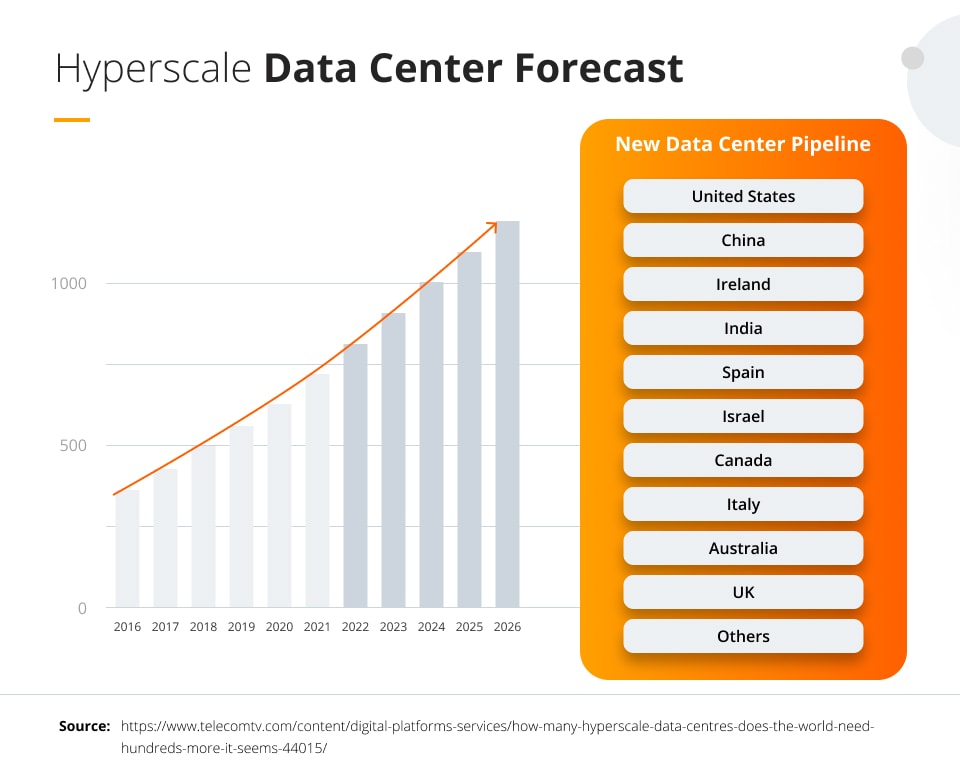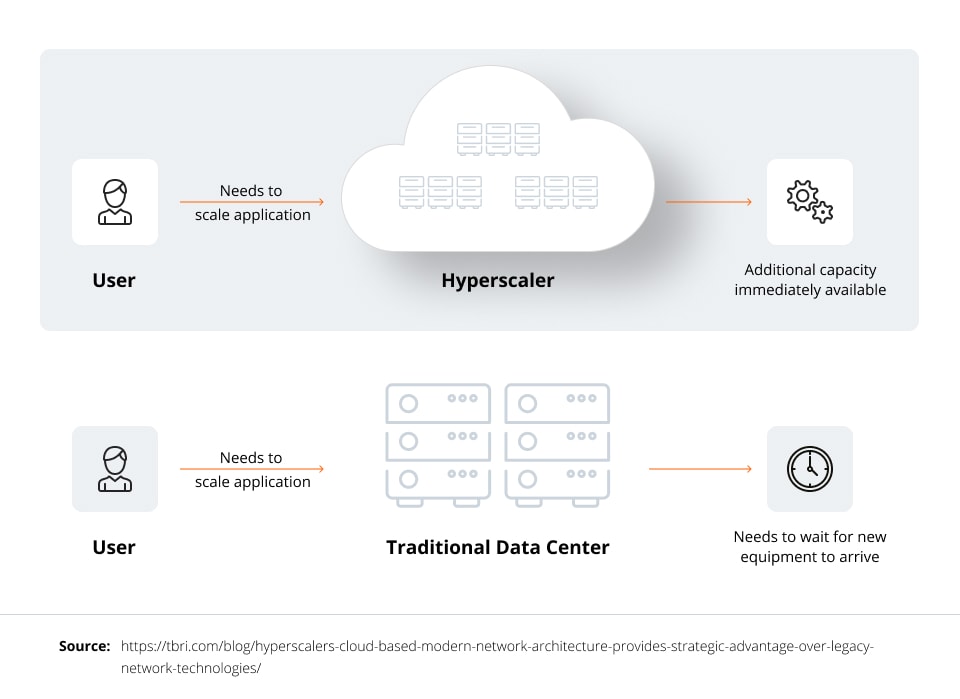
Hyperscale Cloud 101: guide to mega-scaling your business
Data is the lifeblood of most businesses today, and hyperscale computing is emerging as a game-changer. But what is hyperscale computing, and why should you care? Here, we explore the importance of cloud hyperscales in the digital transformation process and learn how companies leverage this technology to drive unprecedented growth.
What exactly is ‘hyperscale computing’? Definition
In cloud computing, hyperscale computing represents a fundamentally new paradigm.
The concept of hyperscale computing refers to the ability to dynamically and exponentially expand computational and storage resources, typically through a distributed, horizontally scalable architecture.
With this approach, resources can be provisioned and de-provisioned rapidly and seamlessly to meet the ever-increasing demands of data-intensive workloads.
Hypercloud service providers can manage workloads ranging from terabytes to petabytes with unprecedented agility and cost-efficiency through horizontal scalability, automated resource management, and the ability to handle terabytes to petabytes.
Why are cloud hyperscalers a game-changer?
A hyperscaler’s game-changing feature is not only its global scale but also its accessibility and agility. Their flexibility allows businesses to respond quickly to market demands and technological shifts while optimising costs.
Businesses are becoming more and more dependent on this level of flexibility to remain competitive in an age where change is the only thing that stays the same.
Cloud hyperscalers redefine the future of cloud security and provide the ideal platform for accelerating digital transformation.
A robust cloud security management system and extensive resources make them stand out. These hyperscale giants offer the scalability and agility required to meet the dynamic needs of businesses.
With advanced security measures and cutting-edge technologies, they empower organisations to innovate, optimise, and compete in the ever-evolving digital world.
AWS hyperscaler and Azure hyperscaler
AWS hyperscaler and Azure hyperscaler are top-tier public cloud top providers.
AWS, or Amazon Web Services, offers a vast suite of cloud services and a global data centre presence.
Azure, Microsoft’s cloud platform, integrates seamlessly with Microsoft products. Choosing a cloud provider depends on distinct technical and ecosystem preferences.
AWS excels with its vast service catalogue, while Azure stands out for its compatibility with Microsoft technologies.
AWS hyperscalers and Azure hyperscalers are transforming cloud computing. Their unparalleled scalability makes the cloud services comparison compelling.
With vast computational resources, global reach, and a diverse range of services, hyperscalers tackle traditional cloud implementation challenges differently. Their ecosystems and strengths make them game-changers in the digital age.
What is a hyperscale data centre?
Hyperscale data centres are at the heart of hyperscale computing. These massive facilities are created to accommodate and manage the staggering amount of computational and storage resources required by hyperscale computing applications, which can be quite demanding.
By automating and redundancy, hyperscale data centres are designed with an infrastructure that minimises the need for human intervention and minimises the use of electrical power too.
Among the key features of hyperscale data centres are advanced cooling systems, robust power supplies, and highly efficient layouts of physical space that make maximum use of the space available.
The data centres are strategically located around the world to minimise latency and ensure redundancy, making them an essential component for delivering high availability and reliable services.
Largest hyperscale data centres
As a true marvel of engineering and technology, hyperscale data centres are among the most impressive and large facilities on the planet.
Among the most prominent examples of this type of data centre are:
- Northern Virginia Data Center (AWS): In the heart of the U.S., AWS’s Northern Virginia data centre offers extensive computational resources and robust connectivity.
- The Dalles (Google): Google’s data centre in The Dalles, Oregon, spans vast acreage and houses cutting-edge infrastructure that supports its services, including Search and YouTube.
- Quincy Data Center (Microsoft): With tremendous processing power, Microsoft’s Quincy data centre supports Microsoft Azure’s rapidly scaling global cloud services.
- Iowa Data Center (Facebook): Energy efficiency is a hallmark of Facebook’s Iowa data centre. Thousands of servers and data storage facilitate the platform’s global social networking and data sharing.
- Changhua County (Taiwan): This is one of Asia’s largest data centres serving cloud and enterprise customers. Connectivity in the region is enhanced by its strategic location.
The essential elements of hyperscale computing
With digital transformation in mind, let’s explore the essential elements of hyperscale computing:
- AI (Artificial Intelligence): Hyperscale cloud environments are fertile ground for AI integration. Data storage and computational resources allow organizations to take advantage of AI. Automating processes, improving customer experiences, and extracting valuable insights from data repositories are among them. Scalability and agility are key to deploying AI applications efficiently.
- ML (Machine Learning): Hyperscale computing provides a nurturing environment for machine learning strategies. These cloud infrastructures can be used to train and deploy machine learning models at scale. Hyperscale computing enables data-driven decisions, task automation, and finding hidden patterns in large datasets.
- Serverless Computing: Serverless computing is readily embraced by hyperscale cloud platforms, liberating businesses from managing servers. This approach improves scalability, efficiency, and cost-effectiveness of cloud solutions. Hyperscale cloud environments benefit from its ability to facilitate application development and deployment.
- Managed Services: Managed services offered by hyperscale cloud providers include database management, security monitoring, and network optimisation. By outsourcing infrastructure maintenance, businesses can focus their efforts on core objectives.
The strategic importance of hyperscalers in Digital Transformation process
Hyperscalers play a strategically vital role in the digital transformation and automation process for several compelling reasons:
- Scalability and flexibility: cloud computing allows rapid adjustments to computing resources to meet the ever-changing demands of digital projects.
- Cost efficiency: businesses can reduce operating costs by judiciously distributing resources.
- Global reach: with hyperscale providers, data is available, redundant, and cost-effective internationally.
- Innovation acceleration: businesses can accelerate digital solution development by outsourcing infrastructure management.
- Data analytics and insights: cloud solutions enable data-driven decision-making and predictive analytics.
- Security and compliance: hyperscale providers adhere to stringent data security and compliance regulations.
How do companies decide what to put in a hyperscale cloud?
While hyperscale computing offers boundless potential, it requires meticulous planning to decide what to entrust to cloud hyperscales.
Data sensitivity, scalability demands, and cost-efficiency are all factors that companies consider when assessing workloads.
With hyperscale clouds, data-intensive tasks and enterprise applications benefit from vast computational resources, allowing them to thrive in the digital transformation era.
The decision is based on a balance between increased demand, scalability, performance, and financial prudence.
Real-world examples of businesses successfully utilising cloud hyperscalers
These companies have greatly benefited from hyperscale computing:
- Netflix: cloud hyperscales enable Netflix to deliver seamless content to millions of viewers worldwide. With hyperscale computing, the infrastructure can be scaled on demand, ensuring uninterrupted streaming.
- Airbnb: to handle fluctuating booking demands and real-time customer service, Airbnb leverages hyperscale computing. This ensures a dynamic market’s reliability and adaptability.
- Deliveroo: a cloud hyperscale platform ensures fast, reliable deliveries for restaurants, riders, and customers. They can dynamically scale resources due to this hyperscale infrastructure.
- Spotify: with hyperscale computing, Spotify efficiently manages large libraries of songs and user data on a single platform. This ensures personalised music recommendations and platform scalability.
- Slack: real-time messaging, file sharing, and collaboration tools are provided by Slack via cloud hyperscales. As a result, its global user base is assured of a high level of availability and reliability.
Adopt hyperscale solutions with Future Processing
Future Processing, a leading technology company, specialises in helping businesses navigate the complex landscape of hyperscale computing.
With a deep understanding of how hyperscale computing works and a track record of successful implementations, Future Processing can be your partner in harnessing the power and benefits of hyperscale computing for your business’s growth.
Our comprehensive Cloud consulting services provide a guide to cloud strategy that aligns seamlessly with your objectives.
From cloud migration services to cloud operations services, we’re your trusted partner in adopting and optimising hyperscale solutions. Experience a digital transformation that drives efficiency and innovation.







